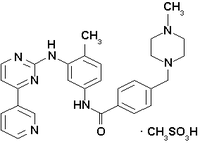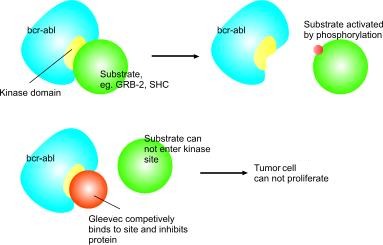Imatinib
|
|
| 4-[(4-methyl-1-piperazinyl)methyl]- N-[4-methyl-3-[[4-(3-pyridinyl)-2-pyrimidinyl]amino]- phenyl]benzamide methanesulfonate | |
| CAS number 152459-95-5 (imatinib) 220127-57-1 (imatinib mesilate) | ATC code L01XX28 |
| Chemical formula | C29H31N7O.CH4SO3 |
| Molecular weight | 589.7 |
| Bioavailability | 98% |
| Metabolism | Hepatic, mainly CYP3A4 |
| Elimination half-life | 18 hours |
| Excretion | Hepatic |
| Pregnancy category | D (Australia) |
| Legal status | ? |
| Routes of administration | Oral |
Imatinib is a drug used to treat certain types of cancer. It is currently marketed by Novartis as Gleevec® (USA) or Glivec® (Europe/Australia) as its mesylate salt, imatinib mesilate (INN). It is occasionally still referred to as CGP57148B or STI571 (especially in older publications). It is used in treating chronic myelogenous leukemia (CML), gastrointestinal stromal tumors (GISTs) and a number of other malignancies.
It is the first member of a new class of agents that act by inhibiting particular tyrosine kinase enzymes, instead of simply inhibiting rapidly dividing cells.
| Contents |
Molecular biology
Imatinib is a 2-phenylaminopyrimidine derivative that functions as a specific inhibitor of a number of tyrosine kinase enzymes. It occupies the TK domain, leading to a decrease in activity.
There are a large number of TK enzymes in the body, including the insulin receptor. Imatinib is specific for the TK domain in abl (the Abelson proto-oncogene), c-kit and PDGF-R (platelet-derived growth factor receptor).
In chronic myelogenous leukemia, the Philadelphia chromosome leads to a fusion protein of abl with bcr (breakpoint cluster region), termed bcr-abl. As this is now a continuously active tyrosine kinase, Imatinib is used to decrease bcr-abl activity.
Imatinib works because p210bcr-abl requires a molecule of ATP to activate tyrosine residues on its substrates by phosphorylation. Imatinib instead docks in to this site and inhibits the protein competitively. Imatinib is quite selective for bcr-abl – it does also inhibit other targets mentioned above, but no known other tyrosine kinases. Imatinib does of course work on the abl protein of all cells but these have additional, normally redundant, pathways which allow the cell to continue to function normally even without this one. Tumour cells, however, have a dependence on bcr-abl (Deininger and Druker, 2003). Inhibition of the bcr-abl tyrosine kinase also stimulates its entry in to the nucleus, where it is unable to perform any of its normal anti-apoptopic functions (Vigneri et al 2001).
Uses
Imatinib is used in chronic myelogenous leukemia (CML), gastrointestinal stromal tumors (GISTs) and a number of other malignancies. Early clinical trials also show its potential for treatment of dermatofibrosarcoma protuberans.
In laboratory settings, imatinib is being used increasingly as an experimental agent to suppress platelet-derived growth factor (PDGF) by inhibiting its receptor (PDGF-Rβ). One of its effects is delaying atherosclerosis in mice with diabetes (Lassila 2004).
Tolerance
Bcr_abl_sti.jpg
In the United States, the Food and Drug Administration has approved Gleevec as first-line treatment for CML (Deininger and Druker 2003). Gleevec has passed through Phase III trials for CML, and has been shown to be more effective than the previous standard treatment of α-interferon and cytarabine. Although the long-term side effects of Gleevec have not yet been ascertained due to the newness of the drug, research shows it is generally very well tolerated (eg. liver toxicity was much less than predicted). Broadly, side effects such as oedema, nausea, rash and musculoskeletal pain are common but mild.
Metabolism
Metabolism of imatinib occurs in the liver and the main metabolite, N-demethylated piperazine derivative, is also active. The major route of elimination is in the bile, only a small portion is excreted in the urine. Most of imatinib is eliminated as metabolites, only 25% is eliminated unchanged. The half-life of imatinib and its main metabolite is 18 and 40 hours, respectively.
History
Imatinib was identified in the late 1990s by Dr Brian J. Druker for the pharmaceutical company Novartis as a potential agent for the use in CML. Its development is the template for rational drug design. Soon after identification of the bcr-abl target, the search for an inhibitor began. Chemists used a high-throughput screen of chemical libraries to identify the molecule 2-phenylaminopyrimidine. This lead compound was then tested and modified by the introduction of methyl and benzamide groups to give it enhanced binding properties, resulting in imatinib (Druker and Lydon 2000).
References
- Deininger M, Druker BJ. Specific Targeted Therapy of Chronic Myelogenous Leukemia with Imatinib. Pharmacol Rev 2003;55:401-423. PMID 12869662.
- Druker BJ, Lydon NB. Lessons learned from the development of an Abl tyrosine kinase inhibitor for chronic myelogenous leukemia. J Clin Invest 2000;105:3-7 (http://www.jci.org/cgi/content/full/105/1/3). PMID 10619854.
- Lassila M, Allen TJ, Cao Z, Thallas V, Jandeleit-Dahm KA, Candido R, Cooper ME. Imatinib attenuates diabetes-associated atherosclerosis. Arterioscler Thromb Vasc Biol 2004;24:935-42. PMID 14988091.
- Vigneri P, Wang JY. Induction of apoptosis in chronic myelogenous leukemia cells through nuclear entrapment of BCR-ABL tyrosine kinase. Nat Med 2001:7:228-234. PMID 11175855.
External link
- Patients' information website (http://www.gleevec.com)de:Imatinib


